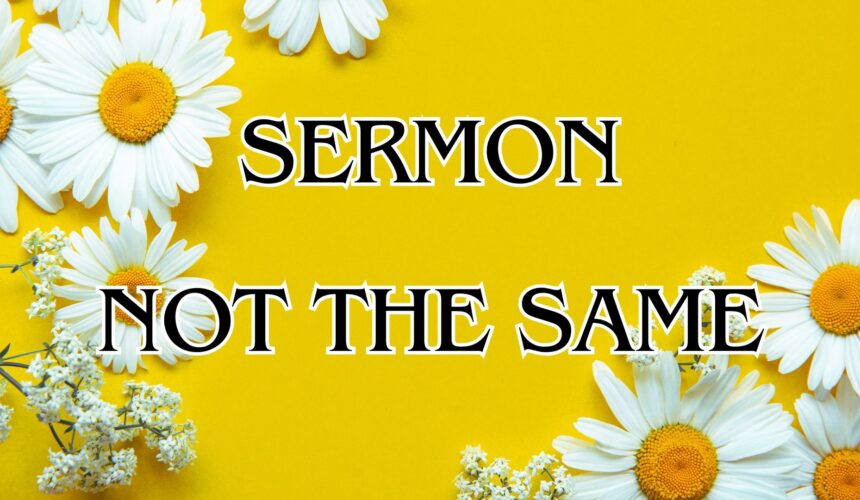May 4, 2025
John 21:1 – 14
Easter in churches is not usually a quiet Sunday morning, and that’s certainly true here at U Park. We have bigger crowds than usual, for one thing. And then there’s the brass quintet, and our pipe organ playing traditional Easter hymns. Our choir sings big anthems, usually two of them. There are Easter egg hunts and children running around in the church courtyard and on the lawn getting pictures taken with family. Friends are excitedly catching up with each other, talking over doughnuts and coffee. Easter morning is anything but quiet.
Which is kind of ironic, in a way. Because the resurrection stories themselves, the Gospel stories of that first Easter morning – they all seem to be very quiet. Matthew’s gospel is maybe the one exception, because there’s an earthquake when the stone is rolled away from the tomb. But even there, the tomb is empty: the resurrection itself took place in the darkness and quiet when no one noticed.
In the Gospel of John, Mary Magdalene is standing alone at dawn in a garden outside an empty tomb when she meets the risen Christ. The two unnamed disciples who meet him in the Gospel of Luke are walking by themselves along a lonely dirt road from Jerusalem to the town of Emmaus when they fall into conversation with a stranger who they eventually realize is Jesus. Last week, we looked at two stories of Disciples huddled in a locked room for fear of the religious authorities, when suddenly Jesus is there among them. There’s no lightning flash or cool theme music, no brass quintet playing “Christ the Lord is Risen Today.” He’s just standing there. These are anything but loud, flashy moments. But out of all the resurrection stories, the one that leaves me with the deepest impression of quiet is the one we heard this morning from the Gospel of John.
Maybe that’s because of an experience I had growing up. Probably a lot of us have had this sort of moment. I was camping on the shore of a lake with a friend’s family when I was 13 or 14 years old.
My friend and I were sharing a tent. We woke up in the very early grey light of predawn. We took his canoe, put on a couple life jackets and grabbed some paddles, and put the little boat in the water as quietly as we could. We paddled out onto the lake, probably a few hundred yards, and then pulled our paddles out of the water and just sat there watching the light gather and grow. I don’t think I’ve ever been in stillness that deep at any time since then. There were no planes flying overhead. We were far away from any road, so there was no traffic noise. There was no high-pitched electronic whine or electrical appliance buzz, none of the normal background noise that’s part of modern life. As the other people on the trip began to come out of their tents, to start a fire and make coffee on the shore, we could clearly hear every word they said because of the way sound carries on still water, even though we were almost on the other side of the lake.
Whenever I read the story we just heard from the Gospel of John, I imagine it must have been kind of like that. The disciples have been out all night fishing, but they’ve caught nothing. John tells us they’re about 100 yards offshore when they see somebody standing there next to a little fire on the beach. And it’s so quiet they can have a conversation across the water. The Gospel tells us the person on the shore says, “children, you have no fish, have you?” And they say, no, they don’t. Just as he did to Mary Magdalene, just as he did to the two disciples walking on the road to Emmaus, the Christ visits them looking like a stranger. And then of course, following his instructions, they bring in a huge haul of fish, and they realize who this stranger must be.
It’s interesting to me that this quiet little story is included in the Gospel at all. For a long time, most Bible scholars have believed that the original ending to John’s Gospel comes just before this story, at the very end of Chapter 20. The author writes, “Now Jesus did many other signs in the presence of his disciples, which are not written in this book. But these are written so you may come to believe that Jesus is the Messiah, the Son of God, and that through believing you may have life in his name.”
That sounds like an ending to me. It sounds like the author of this Gospel has wrapped up the message and put a bow on it and told us what it’s supposed to mean and why it’s written the way it is. So why is this extra resurrection story tacked on after the ending was already written?
Scholars have argued over this for centuries, and the argument is by no means over. I’m no Bible scholar, so I’m not going to weigh in on those technical debates about Greek verb tense and the nature of miracles or signs in the Gospel of John. But I do think there’s actually a very good reason to offer this little story on the end. The author says the book is written so people may come to believe and have life in Jesus’ name. But the Gospel doesn’t answer the question of how that looks or what happens next. I think this quiet moment on the beach points to that important question for first century Christians who originally heard these stories, and for us now.
That 21st chapter, the story after the ending, begins “after these things, Jesus showed himself again…” It doesn’t say when, or how long after the resurrection and the other appearances we’re picking up the story. It’s just sort of…later. There are seven disciples, gathered on the shore of the Sea of Tiberias (which by the way is also called the Sea of Galilee; it’s the same body of water, this big freshwater lake in Israel). There’s no indication in the story of what they’ve been doing since the last resurrection appearance. There’s no explanation of why they are where they are; no reason given for them to be on the edge of the lake. They’re just there. And with no warning or explanation, Peter decides to go fishing and the others say they’ll go with him.
Now maybe they’re going just because they need to make a living. These are not wealthy people. They’re not big landowners or money lenders or tax collectors. They don’t have savings accounts. So they probably need to make some money or get some fish to eat. But I wonder if there’s more to it. I wonder how much of their motive is really that they just don’t know what else to do.
For three years, or maybe a little more, these people have traveled with Jesus. They’ve seen the miracles, what the Gospel of John calls “the signs,” that he’s performed – these healings and supernatural feats that point toward God and show who God is. They’ve learned from Jesus. They’ve learned a new way of life and a new way of understanding who they are and their history and their faith tradition. They’ve seen him arrested and executed and then they’ve seen him alive again. He’s told them that as God sent him, so he sends them. So for three years, it’s been quite a ride, to say the least. But he doesn’t tell them where he’s sending them or what they’re supposed to do next. And I’m guessing that at this point in the story they don’t really know. So there they are, standing on the lakeshore, and Peter says, “Well, I guess I’m going fishing.” And the others with him say, “well, I guess we’re going with you.”
I think that in a way, all four resurrection stories in the Gospel of John are stories about people who don’t know what to do next. Mary Magdalene is standing in the garden weeping, because she thinks grave robbers have stolen the body. She has no idea how to respond. That evening, some of the disciples are hiding out in a locked room because they don’t know where else to be, and they’re afraid, and none of them seem to have any brilliant ideas about their next move. A week later, even after meeting the risen Christ, they’re back in that same room, this time with Thomas. They’re still behind closed doors and don’t seem to have hatched any master plan to propel their movement forward.
And now here they are in this final story in John’s Gospel, which like I said takes place after some sort of unspecified interval of time – it doesn’t really say how long. And it still doesn’t look like inspiration has struck. They’re down by the lakeshore wondering what to do next. They know they want to be followers of Jesus. They just don’t quite know what that means in this new landscape. And in all four of those moments, Jesus offers them what they really need. He doesn’t give them a clear, step by step cookbook style set of instructions. Instead, he offers them his presence. He calls them by name. He tells them, “peace be with you.” He shows them his scars to let them know it’s truly him, truly with them. He gives them guidance and instruction. He even makes them some breakfast, food for the journey.
The disciples are in a hard position at the end of the Gospels. They can’t go back to who they were. They’ve changed too much. They can’t go back and live their old lives the way they used to because they know that everything is different. But neither do they know how to move forward, at least not yet.
So I think there’s a good reason to put this final resurrection story after what sounds like the ending. Maybe it’s meant to tell us that what sounds like the ending or feels like the ending is not the end. Maybe this story is here to remind us that the Gospel does not get wrapped up neatly with a bow on it and a tidy moral to the story to conclude everything. The Gospel is a beautiful story. But it’s also a challenge to us, to continue the story through our lives and the community we form together, in all its messiness and questioning and uncertainty.
I think a lot of us right now, and maybe for most of our lives, are like those first disciples. We can’t go back to what we used to be or do. We’re not the same. But the way forward isn’t clear. What it means to be a follower of Christ here and now, in the 21st century in the United States, that’s not clear. I’ve heard this a lot lately. I’ve long since lost count of the people who’ve told me they don’t know what to do next; that they do not have any clarity on what we are called to do as followers of Christ in this time.
But I guess the upside to our situation is that it’s not so different from the circumstances faced by those first disciples. And maybe these resurrection stories in the Gospel of John can offer us some hope. The risen Christ does not give us step by step instructions. Instead, he offers companionship, peace, challenge, strength, food for the journey. He offers what we need to take the next faithful step – even something as simple as putting the net down on the other side of the boat. On those quiet mornings when our nights have been long and we are hungry and tired and our efforts have not been rewarded, his voice will carry across whatever water we are trying to navigate. Like those first apostles, we will find the courage and light we need to discover our next steps.


